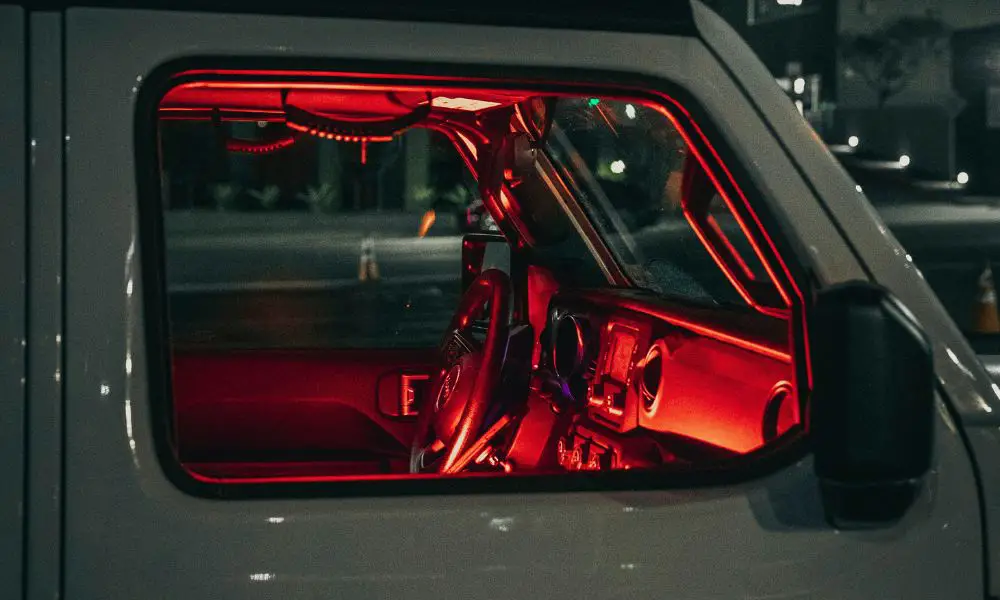You may have seen it before. You glance into a police car, long haul truck, or even a work pickup truck, and you notice that they have red interior lights instead of the soft-white style you have in your car. Is this just for show, or is there a real reason you would have this different color in your cab?
Ultimately, this really comes down to giving the best night vision possible. Red lights don’t glare nearly as much as white lights, meaning they don’t require your eyes to dilate as much, resulting with you keeping your night vision while still being able to have some light in the cabin of your vehicle.
Now, that isn’t the whole story, so let’s dig into this, and the other two reasons people have red lighting on the interior of their cars.
Jump to:
1. To Maintain your night vision
As mentioned earlier, this is the main reason you will see different vehicles with red lights! This light color is less harsh to our eyes than a standard light bulb in a night setting.
Your eyes don’t dilate nearly as much, and if you need to quickly switch from looking at paperwork to needing to drive at a moment’s notice, you don’t have to wait for your eyes to adjust, saving you plenty of time.
This is extremely helpful for Police Officers, who are generally in their cars for long periods working on paperwork at night. However, they get called onto the road and need to do it quickly, without hesitation!
Red lights allow police officers to immediately turn off the red lighting and drive safely. Meanwhile, standard lights would keep them stationary for up to thirty seconds before they could drive away to allow their night sight to return.
Long-haul truck drivers also benefit from this in a similar way as well. They can pull over quickly, turn on their red lighting, do what they need, and then begin driving again without delay. Alternatively, if they need to turn on their lighting while driving it also will not affect their visibility for the short time the lights are on.
Now, pickup truck drivers can utilize these red lights for work situations and off-roading adventures! White lights are blinding, which isn’t very helpful on a job sight and especially not helpful when you are trying to navigate rocky terrain. Being able to switch from looking at a map with the red lights to making their way around a boulder can mean the difference between a damaged truck and not.
2. Red lights don’t glare as much as regular lights.

Not only do red lights help with your night vision, but they also don’t glare nearly as much as white lights do. Because of this, these lights can be utilized by a passenger in the vehicle while the driver drives (you shouldn’t do this unless it’s an emergency, and even then, off-road use only).
Glare on windshields, dashes, side windows, and mirrors can hide things (creating a blind spot). Red lights keep that glare from happening, resulting in a much safer environment for the driver!
This is, of course, helpful for police officers with passengers, truck drivers that drive with a secondary driver, and, of course, families that go off-roading together.
3. The red lighting looks cool.
Some pickups (or cars) especially have red interior lighting because they look cool. Modifying your vehicle to be different from stock is fun, including interior lighting. Many people easily switch out their interior bulbs because they are cheap, easy to install, and make a big difference in the feel of your vehicle.
Of course, it’s up to the eyes of the beholder if this is cool or not, but it is a big reason you will find red lighting on the interiors of vehicles! Generally speaking, though, most people who do this have yet to learn why red lights are used (unless they read this article).
Can you install red interior lighting in your vehicle?
If you fall into one of the people who need one of the three categories above, then you want to add red interior lighting to your vehicle! Thankfully, this is actually an easy process for any car.
Firstly, you can switch out the ceiling lighting by installing new LED bulbs and installing them just like any other light! This is the quickest and most helpful way of upgrading your interior lighting game.
However, if you want to go a little more overboard. In that case, you can also buy some really cool LED strips that can give you some red ambient lighting in the foot well of the vehicle. This looks great and gives you some indirect (less blinding) light in the cabin. These are generally installed with double-sided tape and are easy to install and remove whenever possible.
Please note: Check with local laws on interior lighting before proceeding with these installs.
Frequently Asked Questions
Is red lighting expensive to install?
Adding red lighting to your vehicle is a relatively inexpensive thing to do. If you can do it yourself, you could have red lighting in your car for as little as fifteen dollars. However, you can always go all out and spend hundreds to have your vehicle professionally done at a shop. It really is up to you.
Do I have to have red lighting to go off-roading?
No one HAS to have red lighting to go off-roading. If you are willing to turn on your interior lighting to read your map or eat and then wait 30 seconds to let your eyes adjust at night, you can do without adding red lighting in your pickup.





